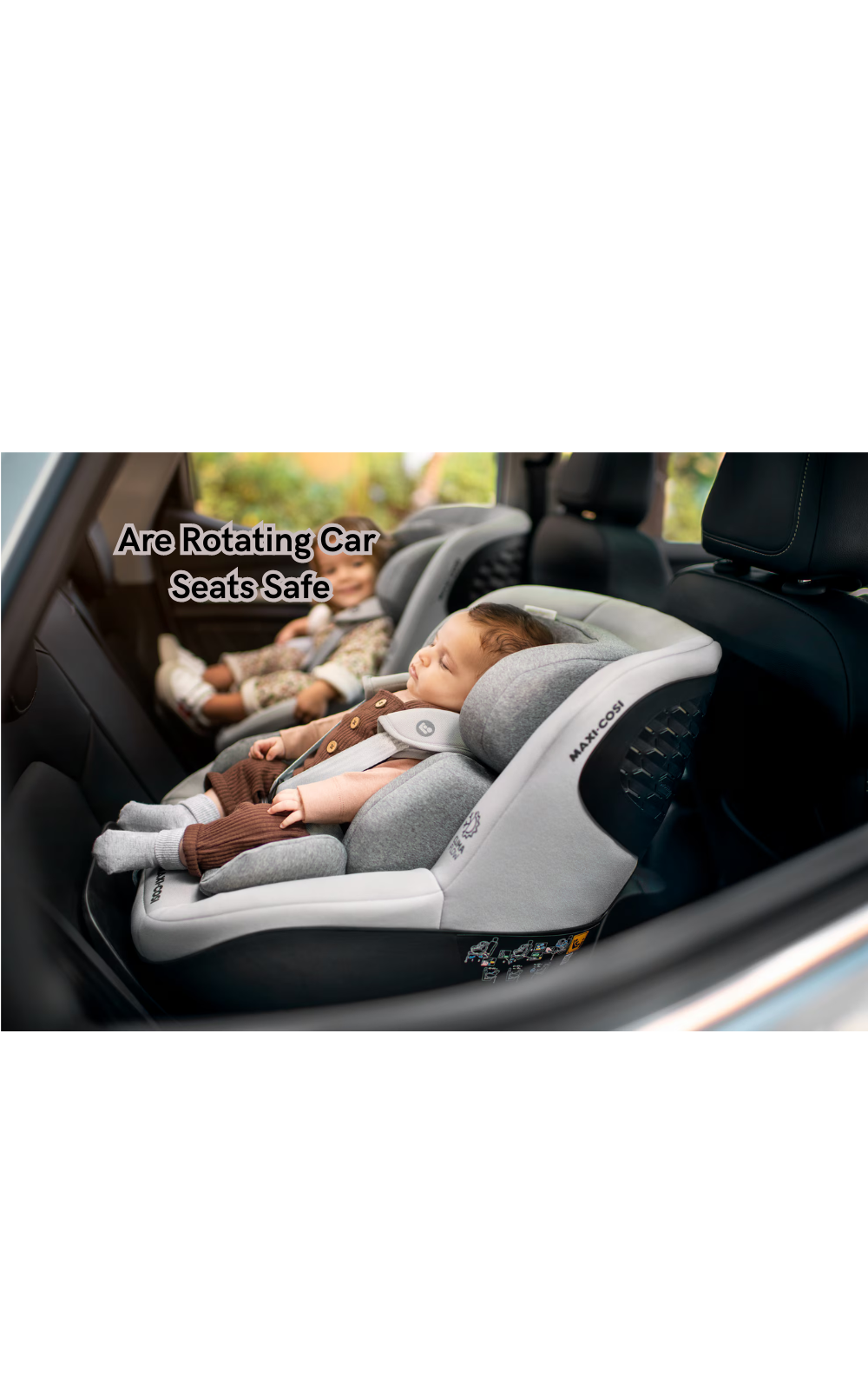Are Rotating Car Seats Safe
This introduction delves into the balance between convenience and safety, shedding light on the key considerations surrounding the use of rotating car seats in vehicles.

Rotating car seats offers a convenient solution for easier vehicle access, especially for individuals with mobility challenges. However, safety remains a paramount concern in the design and functionality of these seats.
While rotating seats can enhance comfort and accessibility, it's crucial to evaluate their safety features rigorously. Understanding the structural integrity, crash protection mechanisms, and compliance with safety standards is essential when considering the safety of rotating car seats.
This introduction delves into the balance between convenience and safety, shedding light on the key considerations surrounding the use of rotating car seats in vehicles.
What Does Rotating Seat Mean for a Car
A rotating car seat is designed to swivel, allowing the occupant to turn towards the vehicle's door or exit. They come in various styles, including manually operated and power-assisted seats. The rotating feature offers several benefits, such as easier access for individuals with mobility issues or parents handling young children.
Some models also feature additional features like adjustable heights and reclining positions, providing added comfort for passengers during long journeys. However, these functions should not compromise safety. So swivel car seats safety depend on multiple factors that require careful consideration.
Types of Car Seats that Rotate
There are primarily three types of rotating car seats available in the market, each with its unique features and benefits.
Infant Car Seats
Infant car seats are designed for newborns and young babies weighing between 4 to 40 pounds. These seats come with a detachable carrier that can be removed from the base for easy transportation of the baby without disturbing them.
Some models offer a rotating mechanism, making it easier to load and unload the baby from the vehicle. Only rotating seat types for infants are rear-facing to provide better protection in case of a collision.
Convertible Car Seats
Convertible car seat options can accommodate both infants and toddlers, with a weight limit of up to 65 pounds. These seats have multiple recline positions and adjustable features, making them suitable for growing children.
Some models also feature rotating capabilities, allowing parents to access their child from any angle easily. Car seat safety standards for infants and toddlers apply to convertible car seats as well, ensuring compliance with safety regulations.
Combination Car Seats
Combination car seats are designed for older children weighing between 40 to 120 pounds. They combine features of infant and convertible car seats, providing extended use as the child grows. Some models may come with a rotating base or swivel feature, offering convenient access for parents while ensuring the safety of their children.
Rear-facing mode is usually not available for combination car seats, so it's crucial to consider the child's age and weight before choosing this type of rotating seat. A facing position is essential for infants and young toddlers to provide maximum protection in case of a collision.
These are the main types of rotating car seats available in the market, each catering to different age groups and weight limits.
Are Rotating Car Seats Safe for Children
Parents may wonder if rotating car seats are safe for their children. The answer is it depends on the design and implementation of the seat's safety features.
For instance, some rotating car seat models include a five-point harness system to secure the child in place during travel, similar to traditional car seats. These models also undergo extensive crash testing to ensure they meet safety standards set by organizations such as the National Highway Traffic Safety Administration (NHTSA).
However, it's crucial to note that not all rotating car seats are designed with children in mind. Some models are more suitable for adults due to their size and weight capacity, making it essential to carefully read the manufacturer's guidelines before using them for children.
So, other rotating car seats may require the use of seat belt systems instead of a five-point harness, which may not provide the same level of protection for young children. Swivel seats may also have a higher risk of ejection in the event of an accident due to their design and rotation mechanism.
Therefore, when considering rotating car seats for children, it's essential to ensure that the seat has been specifically designed and tested for their age and weight range, providing adequate protection in case of a crash.
Safety Considerations for Rotating Car Seats
Before purchasing or using a rotating car seat, it's important to consider the following safety factors:
Design and Structural Integrity :
Rotating car seats come in various designs, each with unique structural features that impact their safety. When examining the safety of these seats, it's essential to consider factors such as the materials used, construction methods, and overall stability.
Materials like metal and high-strength plastics are often used in manufacturing rotating car seats due to their durability and strength. However, rigorous testing is necessary to ensure that these materials can withstand the forces exerted during a crash.
Additionally, the design of rotating car seats must also consider occupant protection during rollover accidents. The seat's structure should provide adequate support to prevent ejection or excessive movement during a rollover event.
Crash Protection Mechanisms :
Rotating car seats must also include crash protection mechanisms to ensure the safety of occupants during accidents. These may include features like energy-absorbing foam, reinforced headrests, and side-impact protection.
The seat's swivel mechanism should also be designed in a way that does not compromise the effectiveness of these safety features. For example, the swivel base should remain locked in place during travel to prevent sudden movement or rotation in case of an impact.
Seat belt systems should also be properly secured and functional, providing maximum protection for the occupant. Middle-seat car safety is especially important for parents who may have multiple children using rotating car seats in a single vehicle.
Compliance with Safety Standards :
When purchasing a rotating car seat, it's crucial to check for compliance with safety standards set by organizations such as NHTSA and the European Union (EU). These standards outline specific requirements for materials, design, and testing procedures to ensure the overall safety of the seat.
Additionally, it's important to follow manufacturer guidelines for proper installation and usage of the rotating car seat. Failure to do so may compromise its safety features and put occupants at risk during accidents.
What Parents Like About Rotating Seats
Despite concerns about safety, many parents still prefer rotating car seats for their convenience and ease of use. Some of the features that make these seats popular among parents include:
- Easier access to children during travel
- Adjustable heights and reclining positions for added comfort
- Ability to install in both rear-facing position and forward-facing modes to accommodate different age groups
- Flexibility in vehicle placement due to the swivel function, making it easier to get in and out of tight spaces
Future Trends in Car Seat Safety
As technology advances, rotating car seats are also evolving to include more advanced safety features. Some of the latest trends in this area include:
- Integration with smart devices for real-time monitoring of seat position and occupant safety during travel
- Implementing artificial intelligence algorithms to predict potential collisions and warn occupants in advance
- Use of 3D printing technology for custom-fit rotating car seats for optimal safety and comfort.
With these advancements, we can expect rotating car seats to continue providing convenience and improved safety for children in the future.
FAQs
Is a 360 car seat safe?
As mentioned earlier, the safety of a rotating car seat depends on its design and implementation of safety features. Some 360 car seat models may be safe for children as they undergo rigorous crash testing and have proper safety mechanisms in place.
Are rotating car seats suitable for all age groups?
Rotating car seats are typically designed for infants and young children, with weight and age restrictions indicated by the manufacturer. It's important to carefully read and follow these guidelines to ensure the seat is suitable for your child's age and size.
Is it worth buying a rotating car seat?
Many parents find rotating car seats to be a convenient and practical option for their families. Ultimately, the decision of whether or not to purchase one depends on your personal preferences and budget.
What is the best age to turn car seats?
The American Academy of Pediatrics recommends keeping children in rear-facing car seats until at least two years of age or until they reach the highest weight or height allowed by their seat's manufacturer.
Conclusion
In conclusion, while rotating car seats offer enhanced accessibility and convenience, ensuring their safety remains paramount. Understanding the design, construction, and safety features of rotating car seats is essential to mitigate any potential risks associated with their use.
By prioritizing safety considerations, such as structural integrity, crash protection mechanisms, and adherence to safety standards, individuals can make informed decisions regarding the installation and utilization of rotating car seats in vehicles.
Striking a balance between convenience and safety is key to enjoying the benefits of rotating car seats without compromising on passenger well-being.
